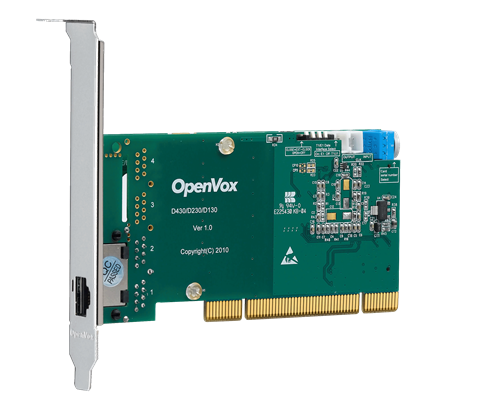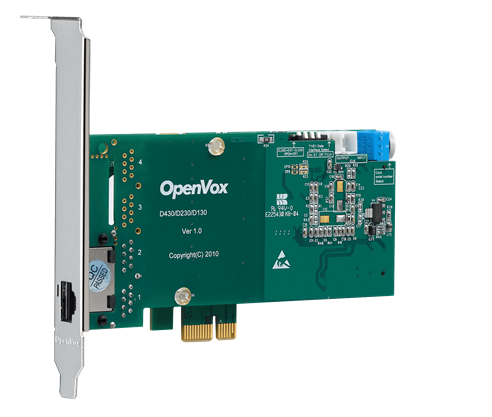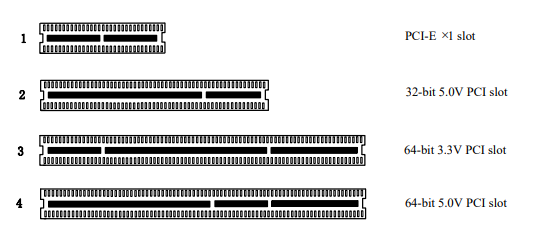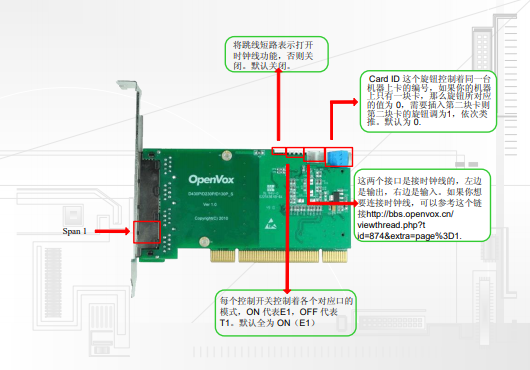D130P/E DE130P/E Hardware Manual


Safety Instructions
1. (a) The D130P/E DE130P/E is subject to specific national safety regulations during application.
2. Turn off the power before installing the D130P/E DE130P/E.
3. To prevent damage to the board by electrostatic induction, please use screws to snap the card stopper to the PC
on the PC to achieve grounding.
4. (b) The electrostatic ring is essential during installation.
5. Please follow the instruction steps.
Chapter 1 Overview
1.1 D130P/E DE130P/E Introduction
The D130P/E DE130P/E is the highest-rated 1-port T1/E1/J1 PCI interface voice card available in the open source community, providing the highest quality voice calls. The advanced innovation of this product not only guarantees the user to reduce the system CPU usage by up to 70% after adjusting the interrupt frequency, but also allows to modify the product interrupt number, thus avoiding interrupt number sharing or conflicts.DE130P consists of D130P and a hardware echo cancellation module based on Octasic® chip. Each card and even each physical port can be freely selected to support T1, E1 and J1 modes. The Octasic® chip-based hardware echo cancellation module can eliminate echo tails up to 128ms or 1024taps on 32 channels in E1 mode or 24 channels in T1/J1 mode. the module takes full advantage of the Octasic® voice quality enhancement feature to ensure perfect sound quality on every call.
The D130P/E DE130P/E supports industry standard telephone line and data protocols, including PRI ISDN (North American and European standards) protocols, PPP, Cisco, HDLC and Frame Relay data modes, as well as line and trunk interfaces.
The D130P/E DE130P/E supports Asterisk®, Issabel, FreeSWITCH™, Yate™ and other IPPBX/IVR open source project applications.
Typical Applications
- High-performance ISDN BRI voice boards
- VoIP services
- IVR Applications
- “Meet-Me” Conference Bridge
- Calling Card Platform
- VoIP gateways (SIP, H.323, and IAX support)
- Traditional PBX/IVR services
- Voice and data routers
Chapter 2 Hardware Installation
2.1 Channel Type Setting
Each DIP switch controls the mode of a channel. By setting the DIP switch, the channel can be set to E1 or T1 mode. When DIP1 is set to ON, it means channel one is E1 mode, and when DIP1 is set to OFF, it means channel one is T1 mode.
2.2 Card ID Setting
If there is only one card on your machine, the value corresponding to the knob should be set to 0. If two D130P/E or DE130P/E are installed at the same time, which means two identical cards are installed, the CardID of the card closest to the CPU should be set to “0 The CardID of the card closest to the CPU should be set to “0”, the card farther away should be set to “1”, and so on. The default state of the knob is 0.
2.3 Slot
D130P/DE130P is compatible with industry standard PCI slots, not compatible with any type of PCI-E slots. Users first need to confirm the slot type and insert the D130P DE130P vertically into any of the above PCI slots. The following figure depicts the four slot shapes.
D130E/DE130E is compatible with industry standard PCI-E ×1, PCI-E ×2, PCI-E ×4, PCI-E ×8, and PCI-E ×16 slots, and is not compatible with any type of PCI slots. Users first need to confirm the slot type by inserting the D130P/E DE130P/E vertically into any of the above PCI-E slots. The following figure depicts the four slot shapes.

Figure 1 PCI and PCI-E slots
Other Features
Users can run the command “ cat /proc/interrupts “ to see if the D130P/E DE130P/E has independent interrupts. if the D130P/E DE130P/E shares interrupts with other devices, it will cause some problems. the D130P/E DE130P/E supports changing the interrupt pin number during firmware upgrade to avoid conflicts. You can check if the EC module is working by using the following command.
2.4 EC module identification and its enable
After completing the installation and configuration by referring to the corresponding board software installation manual, execute the command “dmesg | grep VPM” to check if the EC module is available.
[root@localhost ~]# dmesg | grep VPM
VPM450: echo cancellation for 32 channels
opvxd115 0000:20:00.0: VPM450: hardware DTMF disabled.
opvxd115 0000:20:00.0: VPM450: Present and operational
servicing 1 span(s)
Chapter 3 Reference List
www.openvox.cn
www.digium.com
www.asterisk.org
www.voip-info.org
www.asteriskguru.com
Warm Tips.
Users who encounter any problems during installation and use, please find answers and leave comments on OpenVox forum or wiki.
Appendix A Hardware Specifications
– Weight, Size
Weight: 90g(D130E) 20g(EC2032)
Size: 120×64×16 mm3
– Interface
RJ48 interface
PCI 3.3V or 5V PCI 2.2 or higher
PCI-E PCI-E ×1, PCI-E ×2, PCI-E ×4, PCI-E ×8 and PCI-E ×16 slots
– Environment
Storage temperature: -65 ~ 125°C (D130P) -40 ~ 75°C (EC2032)
Operating temperature: 0 ~ 50°C
Humidity: 10 ~ 90% non-condensing
– Power Consumption
Voltage: 3.3V, 5V
Power loss: 2.43W (min) 6.1W (max)
-Hard and software configuration requirements
RAM 128+ MB
Linux kernel 2.4.X or 2.6.X
CPU 800+ MHz
Appendix B Jumper and Switch Settings

